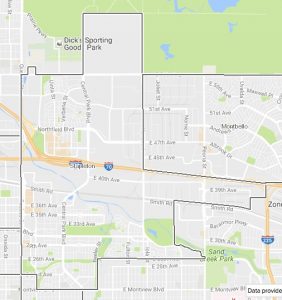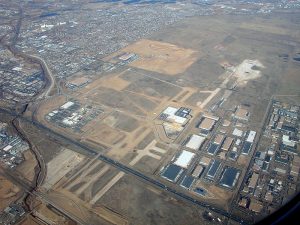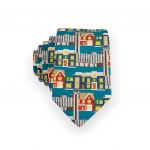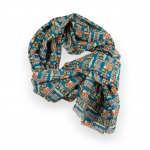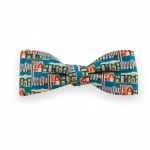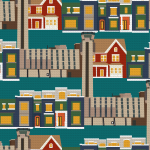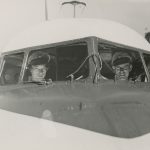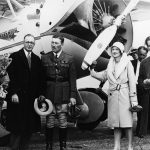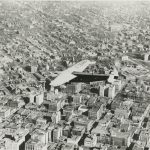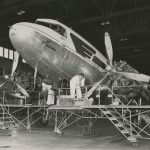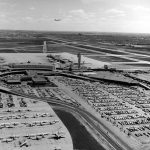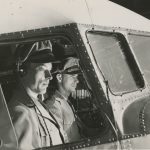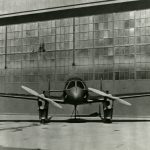“I feel like there’s a real sense of community here in a way that I did not think there would be. I thought it would be fake or something, but I joined this moms club and I met like a hundred other moms–a hundred!! And I hang out with them and I think that’s so cool. It’s just our neighborhood group.”
-Rebekah Henderson, Stapleton neighbor
When Denver voters approved plans to create a new airport, they also created an incredible opportunity for innovative urban development within the city limits. Once Stapleton International Airport closed, the land was sold to Forest City, which has orchestrated the development of the numerous smaller neighborhoods that make up the larger area that is known as Stapleton. The vision includes a variety of home designs and price points including affordable housing options, acres of open space (1/3 of the development is green space), miles of walking trails, public art, shopping districts featuring local businesses and event programming that brings residents together to enjoy live music, farmers markets and more. As residents will tell you, yes, they know the area looks very new and perhaps a bit like The Truman Show, but there is real community to be found there and it’s pretty great to be a “Stapletonian.”
A Brief History of the Stapleton Neighborhood
By Laura Ruttum Senturia
Library Director, Stephen H. Hart Library at History Colorado
It should come as no surprise that the Stapleton neighborhood is one of the newest additions to the Denver landscape. New homes, lawns, and tricycles dot the neighborhood now, but what was there before? Empty fields, one might guess?
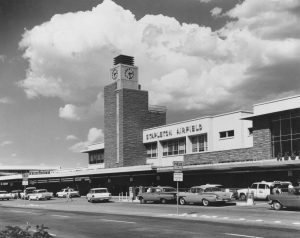
Stapleton Airfield circa 1961. Image courtesy Stephen H. Hart Library & Research Center, History Colorado
Well, yes, to a degree. Anyone who traveled into Denver as late as 1995 was likely to have seen the neighborhood in the form of landing strips and hangars. Yes, that’s right: Stapleton was originally an airport, smack dab in the middle of a city! Well, eventually the airport was located in the middle of the city. Beginning as the “Denver Municipal Airport” in 1929, it was built out on the plains seven miles from downtown, and featured a couple runways and just one hangar. The airport was originally marketed more for recreation and mail delivery than for mass transportation, and served just three airlines: the Mid-Continent Express, the Western Air Express, and U.S. Airways. The little airport continued to grow over the following decades, seeing forty to fifty commercial flights a day by 1945, and receiving its first noise complaints from the neighborhood right around that time as well.
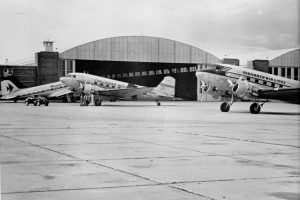
Planes belonging to Monarch Airlines near a hangar at Stapleton circa 1940. Image courtesy Stephen H. Hart Library & Research Center, History Colorado
As commercial air flight began to take hold towards the end of World War II, in 1944 the airport was renamed “Stapleton Airport.” Newcomers to Denver may wonder “who was this Stapleton, and how did he manage to get an airport named after him?” Benjamin F. Stapleton served as Mayor of Denver for two long stints, from 1923-1931, and again from 1935-1947. He was instrumental in developing many of the civic improvement projects Denver saw over that long time period, in particular making use of Federal New Deal “make-work” funds available during the Great Depression. Civic Center Park, Red Rocks Amphitheatre, and yes, you guessed it, the Denver Municipal Airport were all projects which he facilitated. The airport, a project launched by the city under pressure from Mayor Stapleton, was essentially named as a hat tip to the same politician who helped it initially get off of the ground.
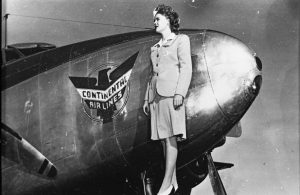
A stewardess circa 1945. Image courtesy Stephen H. Hart Library & Research Center, History Colorado.
Despite Benjamin Stapleton’s roster of municipal improvements, his legacy is a complicated one. During the high-point of the Ku Klux Klan’s influence in Colorado in the 1930s, many white men of influence, from businessmen to bureaucrats, were members of the Klan. Stapleton, too, joined the group and ran as the Klan-supported candidate for mayor. It is difficult today to determine whether he believed in the Klan’s mission, or rather saw membership as politically expedient for election. Whatever his beliefs, his Klan membership is seen by modern eyes as actively racist at worst, and a cynical political choice at best. The neighborhood today, named after the airport that was named after the man, continues to struggle with what it means to memorialize the uglier parts of our history.
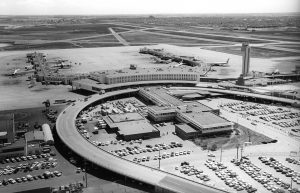
Stapleton Airport circa 1950. Image courtesy Stephen H. Hart Library & Research Center, History Colorado
Returning to the airport, much as the development of the railroad was crucial to Denver’s growth in the 1870s and 1880s, having a large, eventually international airport was an important step for the town. Air travel began to overtake travel by train in the late 1950s and early 1960s, as flight was the most efficient means of bringing in visitors and business. It may be a surprise to anyone who has suffered the indignities of airports and air travel in recent years, but travel by plane was once a luxurious activity for the sophisticated “jet set” (hence that phrase). For cities in the 1950s and 1960s, having an airport put you on the map, and meant you could attract a certain caliber of tourist.
Colorado had already been popular for its national parks prior to the 1950s, but the years after World War II saw men from the 10th Mountain Division (the “troops on skis”) returning to the state to build ski resorts. In short, our fancy new airport brought in a lot of ski tourists, who spent money, and lots of it, while they were here. Due to this ski resort boom towns like Aspen, formerly a small mining community, turned into the playground for the rich and famous that it is today. Our ski industry could not have exploded as it did in the 1960s and 1970s, without Stapleton Airport to facilitate travel.
As Denver’s population, business opportunities, and tourism grew, so too did the airport. Stapleton continually ate up more neighboring land for runways, and built a series of control towers, each taller than the next, every decade or so. In the 1970s, the airport became a major “hub” city serving smaller regional “spokes” for both United and Continental, due to Denver’s unique placement as the largest city in the middle of the Rocky Mountain West. In 1978, the airport saw 18.9 million passengers pass through its doors.
By the 1980s, Stapleton Airport, now largely surrounded by residential neighborhoods and thus unable to expand, began to struggle to keep up with the ever-increasing level in commercial air traffic. Neighborhood complaints about noise pollution also exploded, particularly from the Park Hill residents, living right along a major daily flight path. Pressed to continue developing the economy-supporting potential of the airport, and to address citizens’ complaints, Denver Mayor Federico Peña worked to find Federal funding to build a new airport, far from the ears of fed-up Denverites. As an aside, if any newcomers to Colorado were wondering the source for Denver International Airport’s “Peña Boulevard,” there you go.
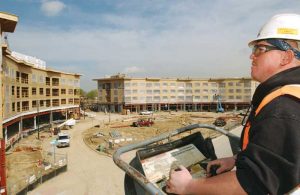
Quebec Square opened in the summer of 2002 and the Town Center opened a year later. The first home was occupied in July, 2002 and the first school opened in the fall of 2003. Image: Front Porch Stapleton
Subsequent Mayor Wellington Webb continued the new airport project, bringing the Denver International Airport to fruition out in the unpopulated plains in 1995. Stapleton International Airport was thus superseded after 67 years, and left its prior home within city limits open for a new interpretation for the land.
It was only a matter of time before a developer, excited by the unique opportunity to start an entire community afresh so close to a major city’s center, moved in. In 2001, Forest City Enterprises did just this, breaking ground on a new type of community: suburban but near downtown, offering a high level of walkability and the yards Denverites so cherish, in addition to a wide variety of home styles and price ranges. As one of Denver’s newest, and in fact still growing communities, Stapleton’s history mostly still lies ahead.
Wrap Stapleton Around Your Neck and Take It Everywhere
“In the early 2000s, the land of the former Stapleton International Airport was transformed into a community and neighborhood. This design is meant to portray the transformation of the identity of Stapleton. By including the iconic old Stapleton Control Tower and contrasting it with the new vibrant homes it illustrates the growth of the neighborhood into a contemporary and bold community. One of the many things that makes Stapleton so interesting is the diversity of new residential and commercial buildings and the preservation of the control tower.” – Christiana Lambert, designer at Knotty Tie
Get your own Stapleton-inspired bowtie, necktie or scarf here: Knotty Tie Co.
Save 20% on your order with code GOPLAYDENVER.
Interview with a Neighbor: Rebekah Henderson (3200 block of Uinta)

When we first moved here, we lived in the Westerly Creek area for a year in a house that my now husband had bought in 2004. Now we live in Central Park West in a house where we’ve been for almost 3 years.
What drew you to this neighborhood?
We’re on our second home in Stapleton and we could have lived a lot of places including in a condo we owned downtown, but we picked Stapleton. We love Stapleton. But first, I want to be clear, I didn’t think I wanted to live here. When we moved back here after living in Oakland, we had just gotten married and we were trying to get pregnant. Our tenant (in the Westerly Creek house Rebekah’s husband had been renting out for years) had given notice and we thought instead of trying to rent it again, we should just move back here. My husband was like, we don’t have to live in that house, we could sell it and live somewhere else, we could live in Park Hill, we could figure something else out.
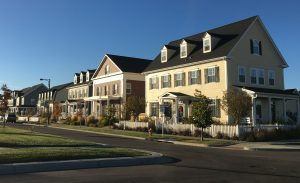
Homes along 29th Ave. Image: Tara Bardeen
I thought I would hate it. When we moved in, I looked down the street and it was like the crazy planet from A Wrinkle in Time, you know, where if the kids bounce the ball wrong, they take them and put them in jail and make them bounce it and bounce it until the do it the right way. That’s what came to mind, it was like The Stepford Wives. I’m from New York and my house growing up was from the 1920s, so all of these new houses just felt weird. I thought, it’s nice and it’s clean and it’s beautiful, but the trees are all short enough to poke you in the eye, and I just didn’t think I was going to like living here. But the more I lived here, the more I started to like it.
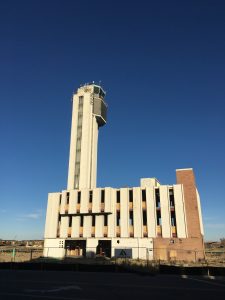
The air control tower from former Stapleton Airport will eventually house a Punch Bowl Social. Image: Tara Bardeen
It’s really new here, but I like that and I’m surprised that I like that. It’s so convenient and that’s huge thing for me. We can walk to the Town Center and we can walk to the train station and get on the train and go downtown, which we do for date nights. If we’re driving, it takes like 15 minutes; you just hop on MLK (Martin Luther King Jr. Blvd.) and you’re downtown. It’s a compromise. In the suburbs we could have a house 3 times as big, but I don’t want to be out there and have to drive to everything. Certainly, this is still Denver and you have to drive places; that’s how the city is. But here in Stapleton, I feel like we can really get around easily. My nanny doesn’t have a car and I’m not even worried about it because if something happened, she could just walk my son to the doctor. That’s how we take him to his checkups; we just put him in a stroller and walk down the sidewalk. We can walk to the library, to the supermarket, to the pharmacy, and to a huge park. We have everything we need in close proximity.
I’ve lived in the Bay Area, Spain, Mexico and Japan and then of course New York–I grew up outside New York City. I feel like there’s a real sense of community here in a way that I did not think there would be. I thought it would be fake or something, but I joined this moms club and I met like a hundred other moms, a hundred!! And I hang out with them and I think that’s so cool. It’s just our neighborhood group. Another group I love is the Central Park Women Who Wine. It’s our wine group in the neighborhood and it’s been the best way for me to meet new people and to meet lots of different people besides stay-at-home moms. I met all of my neighbors through the wine group. We meet once a month at someone’s house and you just bring a bottle of wine. I feel like that has been so awesome because then, when you see someone on the sidewalk, it’s like, oh, she’s in the wine club! I get the feeling that people are looking out for each other here and it’s really nice.

One of the shared green spaces in Stapleton known as a “muse.” Image: Tara Bardeen
On my block, there are two other kids who are the same age as my son. Just on my block! And that does’t even count the house on the muse behind us (in Stapleton, a “muse” is a shared green space that runs down the block between the backsides of the houses. Included in these spaces are benches, landscaping, sandboxes and other play spaces for children and picnic tables) that have kids of various ages too. My son will never be lonely. The kids play together on the muse all the time. Our muse has a sand pit, but there’s a playground on the muse across the street. You don’t even have to go all the way to Central Park to play. People even get married on the muses because it’s a public space that’s like a little park. Stapleton has so many things like this that I just love, like the way we invite each other to everyone’s birthday party, Christmas party and Halloween party.
I like that we’re next to north Park Hill and next to Aurora. When I go to the King Soopers, it looks “normal” to me because there are all kinds of people there. And when you go to the rec center, it seems “normal” to me, being someone coming from the Bay Area, as there are all kinds of people there.
How would you describe the Stapleton neighborhood in 3-5 adjectives?
New, convenient, neighborly.
How would you spend a perfect day in Stapleton?
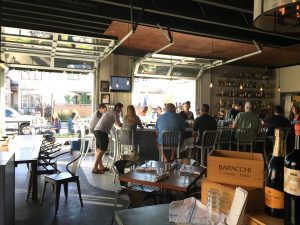
A sunny afternoon at The Bistro at Stapleton (26th & Ulster). Image: Tara Bardeen
For me the perfect day includes getting up and drinking coffee on my front porch if the weather’s nice. We don’t have a build in front of us yet, so we can see all the way to Central Park and we have this nice view of the sky. So I would sit out there and have coffee and then go for a jog in Central Park, which I usually do a couple times week. I love that I can run around the neighborhood and there are plenty of dirt trails. Then to have time to just hang out with my family and my friends. Maybe we’d just pop over to the muse, maybe run into someone and then just chat and perhaps make plans to do something later. Then head over to The Bistro (29th & Ulster) and have a cocktail and dinner and then walk home, put our baby in bed and then go in our hot tub. For me, being able to exercise, eat a nice meal, enjoy some time outdoors, let my kid play, have my neighbors over for a socializing and enjoy my home is like the perfect day. These are the reasons you live here. You can have a really nice house and enjoy it and the community.
If we wanted to go out for a date night, then the perfect day would end with a babysitter and we would walk over to the train. We’d then head to Jax (17th & Wazee) downtown and get oysters. We have loved the new train. We go to Union Station and when people come to visit us we can just pick them up at the train station. It’s so convenient.
What might surprise people about your neighborhood?
It’s not very racially diverse here, so I did not expect to feel as connected as I do to my neighbors. In other places I’ve lived, I’ve never really been friends with my neighbors to the point where it’s like, really, just come over and we’ll watch the game together! But here in Stapleton, I do. And I love that. It feels like just what I wanted when I became a wife and a mother, that sense of community and being able to call some one up and say, “I have to go to work, can you watch my son today?” I’m building that kind of community here and I don’t think that would happen in a different neighborhood.
What are some of the community hubs of your neighborhood?
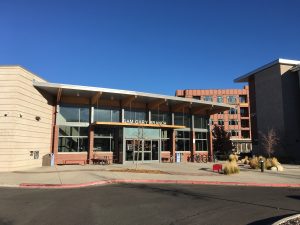
Sam Gary Library has an incredible children’s section in addition to excellent free classes and lectures. Image: Tara Bardeen
One place would be the Bistro at Stapleton (29th & Ulster). We run into people here all the time having a drink because it’s easy to walk to. Stapleton does have an official hub which is the Town Center (29th & Quebec) and especially in the summer with the farmers markets and all the events, we always see neighbors there. The events are really nice and they do really bring people together. I feel like the community tries to be really inclusive.
It’s going to be really cool when Stanley Aviation opens because we’ll be able to bike over there. The library (Sam Gary, 29th & Roslyn) is another place where we’re always bumping into people and the King Soopers (29th & Quebec) of course.
What are your favorite places to walk?
We love to go to Central Park. I love to run the trails over by Westerly Creek because there’s all this great public art. But also just down the main avenues like 29th, which is modeled after the Champs Elysees in Paris. Anywhere really, I feel like you can walk anywhere in the this neighborhood and it’s beautiful.
Live in Stapleton? We’d love to know what your perfect day would include! Email us: [email protected]
More Photos Taken at Stapleton Airport Through the Years
If you want to see even more, just head down to the Stephen H. Hart Library & Research Center at History Colorado (12th & Broadway). You don’t need an appointment, just walk in. It’s free and the librarians are friendly and helpful! You can also check out some of their collection online: h-co.org/collections
Images: All images, unless otherwise noted, are courtesy Stephen H. Hart Library & Research Center, History Colorado.
Source: “An Airport in Place: Stapleton International Airport’s First Fifty-Five Years of Growth,” in Colorado Heritage, 1984, Issue3, by Jeff Miller; “April 2010: Front Porch 10th Anniversary Issue: A Stapleton Retrospective,” in Front Porch, October 29th, 2013, by Carol Roberts.
